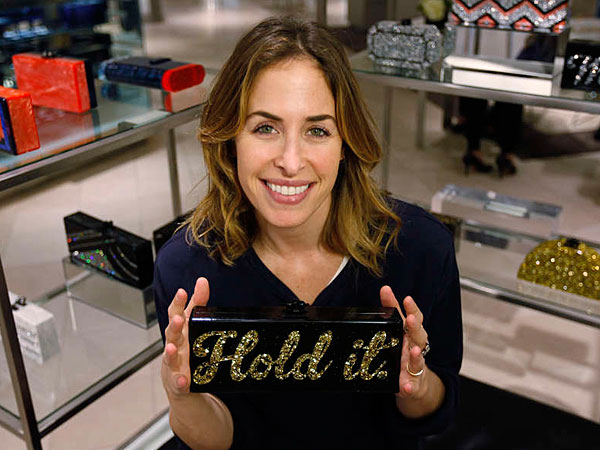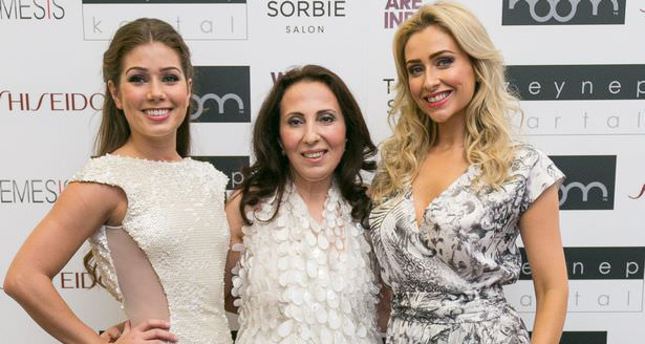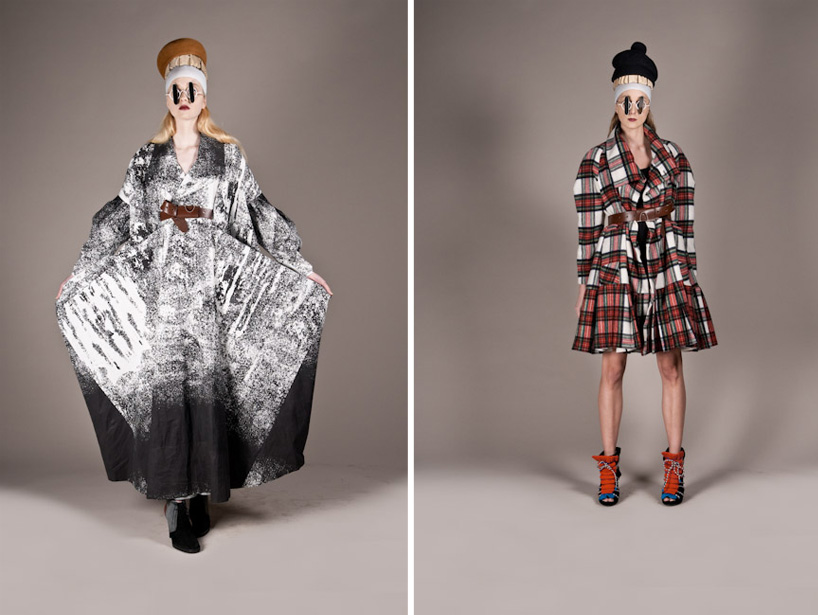Designer Adam Selman’s breakout moment was the dress seen 'round the world.
It was hard to miss the over-230,000 Swarovski crystals hugging every curve of
Rihanna’s body for her crowning as a CFDA Fashion Icon this past June. It was
certainly a look, and it put Selman on the radar of everyone in fashion in a big
way.
The moment came after the 31-year-old Belton, Texas native had been working
with the pop star on both on- and off-stage looks for years. The buzz continued
to build around him up until his spring 2015 show in New York in September,
which included a nod to the now-famous, see-through frock -- and an appearance
by Rihanna herself.
“I was going to make Rihanna a pearl option for the CFDA [Awards] as an extra
piece,” Selman explained to us in his Garment District design studio recently.
“We ended up making it and having it beaded in the same technique, but it just
wasn’t right [for the event]. It was obviously all about the Swarovski dress in
the end, so I took that and expanded on it. I knew that I wanted a 'wow' piece
in the show, but done in my way. So it wasn’t about a gown, it wasn’t full
length; I just wanted to make it cute and I knew people were going to want that
from me.”

It, along with the rest of the collection, was definitely what people wanted.
Since last season, Selman has brought on The Grocery Store in San Francisco,
Net-a-Porter and Intermix as stockists, adding to influential names like Opening
Ceremony, Browns of London; K3, Candy and Whim Gazette all in Tokyo and Rare in
Seoul. It’s been a bit of a slow build: Selman launched his eponymous line in
2013 after over a decade working in the custom sphere, designing costumes for
everyone from Michael Jackson to Britney Spears, The Scissor Sisters, Lady Gaga
and, of course, Rihanna.
Now, Selman is choosing when and how to grow his label. With three
collections already under his belt and a fourth in the works, we chat with the
designer about transitioning from costumes to ready-to-wear, his next collection
and why fans and supporters (like Rihanna) keep coming back.
When exactly did the “fashion bug” bite?
So I originally was going to go to school for sculpture, which is why I went
to Pratt. My parents were like, ‘You need some sort of business’ so I was like,
fine I’ll do fashion. I had done theater and all that nonsense. My mom taught me
how to sew at a really young age because I really wanted a vest growing up so it
was just like a natural progression. I never really knew about 'fashion'
fashion, but it was just a nice transition. I learned more about fashion
whenever I got to New York.
Did you end up learning that business that you were supposed to at Pratt?
Not at all really. But I wasn’t really looking for that either. I was like,
‘I’m a creative guy and I don’t need that. I’m an ideas man.’ So all the
business end has just come from working on it and just being hands-on and
cognizant of what is happening around me. I try to pick up tips as I come to
them and as I grow.
What is one major lesson that you took from your time at Pratt?
I think the biggest advice that a professor gave me was that there are so
many powerful stylists in the world and styling is such a powerful profession
and they do such amazing things with clothes that you always want to make sure
to design your clothes like you would want them styled. So if you don’t want it
to be worn backwards, make it so it can’t be worn backwards. Just make sure to
drive the point home; don’t just say, 'I’ll style it later.' That’s not
designing; that’s styling. Just make sure to design it how you want it to be
worn.
So you interned as most people do. Who were you working for then?
Well I started at Nicole Miller and then a professor told me that a friend
was looking for an intern and that turned out to be Desi Santiago, who was like
a performance artist and jewelry designer. We would, like, make bamboo cuffs and
sit around and eat fried chicken and make jewelry out of the bones. He
introduced me to Zaldy and I interned for Zaldy after that and I worked for him
for 10 years.
Those internships obviously influenced your progression.
Definitely! I think like those internships, working, school, living in New
York and going out played a part. Going from Nicole Miller, I really wanted to
do corporate fashion and athleticwear and things like that. That’s why I went
down that road but when I met Desi and Zaldy, that’s when I switched to
nightlife and the legendary club scene. It just made me look at fashion in a
whole new way and also the possibility in New York that you don’t have to take a
particular road; Just because you want to be a fashion designer, it doesn’t mean
you have to take the most corporate position. That was my New York dream.
Did you find that going out was a big part of your development?
Yeah, I was definitely never a big party boy but I was always going out. I
think it just helped me define my style. You can get away with a lot more after
midnight than you can at noon. I would always wear like denim head to toe: skin
tight jeans, cowboy boots, denim, denim, denim. Or like denim Daisy Dukes. It
really just helped me develop my own voice like ‘this is me, this is who I am
and who I want to portray.’ That was always evolving, but that’s what I learned
about myself. Plus, you meet fun people and you just end up having a lot of
fun.
So at what point did you decide you wanted to go into costume design?
Well I always knew that I wanted to be my own boss and I worked freelance for
Zaldy, so I was my own boss in a way. He had a fashion collection for like four
years and he stopped doing that and started doing the custom stuff, which I had
a huge part to do with. We had like RuPaul, Michael Jackson, Britney Spears,
Rufus Wainright and the Scissor Sisters. I went on tour with the Scissor Sisters
for two years and was sort of like their ‘wardrobe boy.’ I really learned what
worked on the road and what worked for stage -- that was a huge thing, just
learning what worked.
After that, we were working on Britney Spears for Zaldy; and Mel Ottenberg,
who was my boyfriend at the time [and still is], got the job [styling] Rihanna
and he had never done stage/performance stuff, so he asked could I help.
Originally, I was just going to consult and keep working with Zaldy on the
Britney tour, but the next thing you know I’m doing half the costumes in a super
tiny space with a friend of mine. It was so surreal. It just happened, it was
never like ‘I need to branch out, I need to leave.’ It just organically
happened.
Why do you think Rihanna has kept working with you all of this time?
I think the Mel connection didn’t hurt. But also, I think it was because we
really worked on it together. Even when other people were making custom things,
I’d have a voice in that as well to make sure it was the right fabric and the
right fit. But I think my motto, especially with Rihanna, is that a lady likes
options. So if they asked for a red dress because they were going to shoot a
video, or there was one reference that they really liked, I would show up with
that red dress and three other red dresses and then I’d throw some wild card in
there. I just wanted to keep it going so that she’d be like, ‘oh wow I have to
keep him around,’ and she did. I just wanted to show her that I was always
pushing and I wanted to show her what I could do. I mean, I really needed that
job.
Did you employ that same strategy of creating lots of options when you
started doing your own collection?
Definitely! I like playing with pattern and playing with shape, so a lot of
things will be the same pattern but I’ll make it in silk and I’ll make it as a
sweatshirt. That way I’ll see which one works better and sometimes they both
look great or only one looks great. I like to give myself options too to make
sure I’m doing the right thing. Sometimes I present that to buyers but sometimes
it’s like, that was an epic fail. But that’s fun too, though.
Is it just you making that selection process or is it your whole team?
It’s really my whole team. That’s everyone in the studio like Marley
[Glassroth] and Bri [Magnificio] -- I rely on my girls heavily -- but I also get
Mel involved and Jen Brill, who helps me with creative and I like to get her
opinion on the clothes as well because she’s my kind of girl. But it’s really
just getting all of them involved.
So when you’re coming from not getting too much of the business side in
school and then doing one-off, custom pieces, what is going into the buying
process like?
I really like it because I love feedback. I like to hear what people are
saying. I did my sales the first season and I was like ‘OK, I never want to do
that again.’ I hired Goods and Services because Joey, who owns it, is a friend
of mine. They’ve been great in helping me shape my collection. They’ll give good
advice like ‘maybe you want to think about this,’ or ‘don’t go too far down that
development road, you should focus on this.’
Each season I’m trying to grow a little bit. So this upcoming season is knits
and this past season was this “denim not denim” story. So each season I’m trying
to capture a little bit more. With sales and press and buyers, it all plays
in.
With that last “denim not denim” collection, is there a reason you decided to
finally do a runway show? Even though it still had the feel of a presentation,
it was really a small runway show.
I wanted it to be really fun and really intimate and I also wanted the
pictures to be great. I wanted to make sure that I had really clear shots of the
clothes on the runway and also in the vignettes. The inspiration for the set
really came from Laura Mars and just those vignettes from the movie. That’s what
I live for in fashion, it’s that moment. So I wanted these groupings of girls,
under my name, giving you a moment.
When you’re going to design, how do you shift from designing for one person
to designing your line.
I still keep my sensibilities, but if it’s for, like, Amy Sedaris, I know she
likes pom poms and [a particular] fit of something, so I’m always thinking about
her. That goes for Amy, Beyonce, Lorde; I’m thinking about them as opposed to
the idea that I’m trying to get across and the clothes that are going to do well
in stores and the overall feeling of the collection and the mood of it all.
So thinking about the future, where are you looking to expand to?
Well I’d love to do men’s! I’d also love to do accessories -- well more
accessories -- and bags. I don’t really want to do an ‘It bag’ situation but
each season I do a bag. I did a jumbo backpack and then I did a boucle backpack.
This time, I did these baby bags and these little raffia bags. I mean everybody
needs a bag.
Next time I might do a little evening but for the most part I think evening
and gowns are more of an earned thing for a designer. So before I do evening I
want to make sure that the clothes are in the stores and are selling well. I’ve
already got great celebrity things. I mean, I want that and obviously need it
but I’m not focused on getting a celebrity in my clothes, I’m more focused on
getting the clothes in the stores and just getting them on girls.
www.queenieaustralia.com/cheap-formal-dresses





